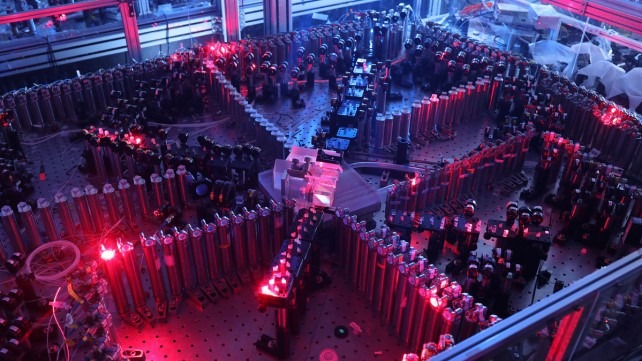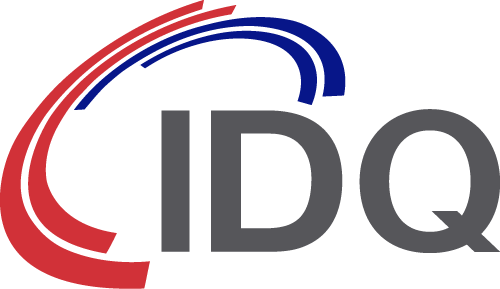Quantum Advantage Demonstrated with Photons
by Bruno Hutner
Last month, a group led by Prof. Pan of the University of Science and Technology of China demonstrated quantum advantage with a photonic quantum computer. This means that they used a quantum system to perform a computation, which would basically be intractable with a classical computer. This represents a new milestone in the rapid progress in quantum computing we have witnessed during the last few years.
Indeed, although Google reported quantum advantage a year earlier with a superconducting quantum computer, this is the first time that a photonic system convincingly outperforms classical computers. And quite significantly so: the computation was faster than a state-of-the art simulation with a supercomputer by a factor 1014. If this looks like a large number, it is! The quantum computer, named Juizhang, performed the calculation in mere minutes, while the team estimated that it would take 2 billion years with a classical supercomputer.
Principle of a Photonic Quantum Computer
Photonic quantum computers have some very appealing features. Photonic qubits are relatively easy to generate and later measure. They interact very weakly with their environment, can easily be transferred from one point to another (this is the heart of quantum communication), and do not require the low temperatures normally needed by their solid-state counterparts. However, this is also their weak point: photons do not interact with one another. In a more standard gate model of the quantum computer, the qubits would interact with one another, to generate so-called entangled states. These states are at the heart of the magic of quantum computers. So, how can you make a computation if you cannot have any interaction between photons? Well, this is where another type of quantum magic comes into play. Photons are a type of particle known as bosons. Bosons have a tendency to stick together. If you send two independent but indistinguishable bosons on each side of an optical prism for example, say one from the right and one from the left, they will stay together and go either two to the right or two to the left. So, due to their bosonic character, one photon can indeed somehow control the behaviour of the second one. This is the type of interaction, which is used in photonic quantum computers.
Juizhang and Boson Sampling
Juizhang is far from a general-purpose computer. It is a specific design, which can execute only one computation, known as Boson Sampling. You can picture it as a pinball machine, but without the flippers. You drop the ball from the top of the machine. It dribbles down towards the bottom, bouncing on the various bumpers, to finally arrive in one of several slots. However, this is not enough. A pinball machine only has one input slot on the top. Our system is much wider, with many slots, so you can drop many similar balls at the same time. Computationally speaking, the input is the number and the positions of the initial balls. The computing machine is the fixed setup of bumpers. The output is the distribution of balls in the bottom slots. Replace the balls by photons, the bumpers by prisms and mirrors, add detectors in each of the bottom slots to monitor the number of photons, and you have a rather good analogy. Simulating the classical system (with the real balls) is relatively easy with a classical computer. However, the bar is higher when we deal with quantum objects. This is due to the interference between various possible paths and to the boson interaction described above. An amusing anecdote: initially the article provided classical simulations up to 30 input photons. The referee told the authors that it would be interesting to have larger simulations if possible. They obliged, and increased the input up to 40 photons, burning about $400’000 worth of computer time. The largest number of detected photons in Juizhang was 76, far above what was possible to simulate classically.

Juizhang has 100 different input slots, populated with up to 50 input states, a pinball machine with 300 prisms and 75 mirrors, and 100 bottom slots with detectors[1]. Generating 50 indistinguishable states at the same time, aligning, synchronizing and stabilizing this complex system is a tremendous achievement, that was thought to be entirely impossible. Hats off to the team, which managed this.
Towards the future
Where do we go from there? Juizhang demonstrates that a photonic quantum device can perform a computation, which is impossible to simulate efficiently with a classical computer. Unfortunately, Boson sampling does not have a clear immediate application. However, there are some proposals to apply it to some other problems. Even more interestingly, a dynamic setup, where you can adapt the mirrors and prisms according to partial measurements would make it a universal quantum computer. To go back to our analogy: adding the flippers to our pinball machine does make it much more fun!
One big issue with the current system is how to scale it. It will be very difficult to do so with the same bulk optic components. The path forward is integration. This is followed by several startups, such as Xanadu and the more secretive PsiQuantum, which are developing optical chips with all the components needed. In addition, demonstrating the quantum advantage is a real boost for companies in the quantum optical ecosystem, which develop the building blocks. For example, Nu Quantum wants to build real single photon sources, which could be used in the next generation of optical quantum computers. ID Quantique and several other companies are continuously working on improved single-photon detectors.
At ID Quantique, we already use the quantum properties of light for very practical quantum random number generators, and for quantum key distribution, which improve the security of communications. Photons are obviously still in the race for all kinds of quantum applications. So, stay tuned, the game is not over yet…
[1] Here, the careful reader should wonder how you can detect 76 photons with only 50 input states. The answer is that the input states were not single photons, as described, but peculiar quantum states called squeezed states, which are built from a superposition of various number states. What Juizhang did then was not true Boson sampling (with single photons), but Gaussian Boson sampling (with squeezed states). At this stage, if you really wan to get to the bottom of this, I can recommend a few interesting reads: Daniel Garristo in Scientific American and the blog of Scott Aaronson.


